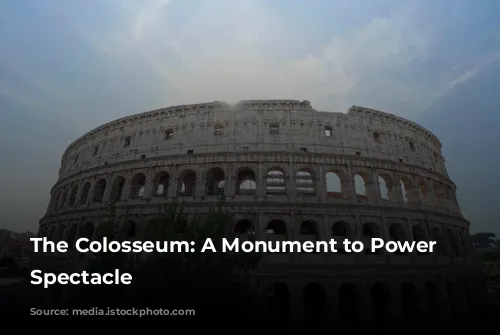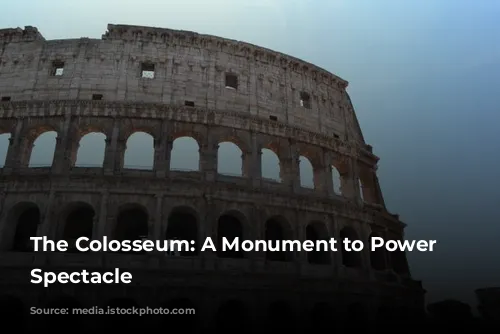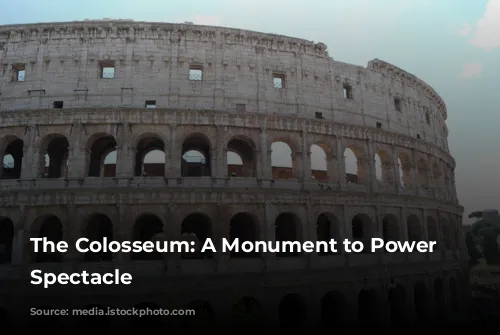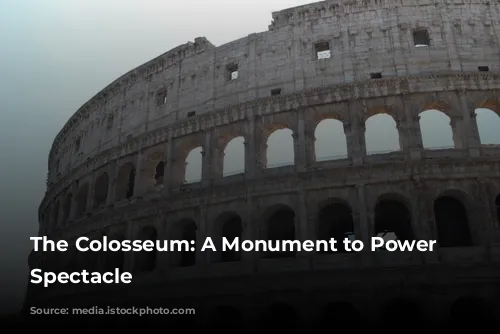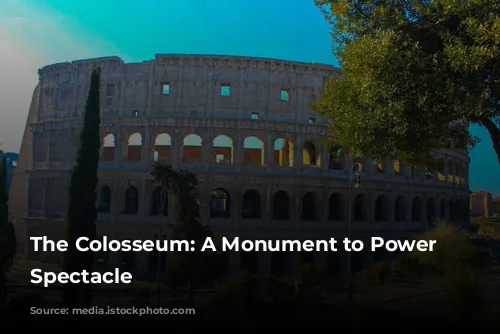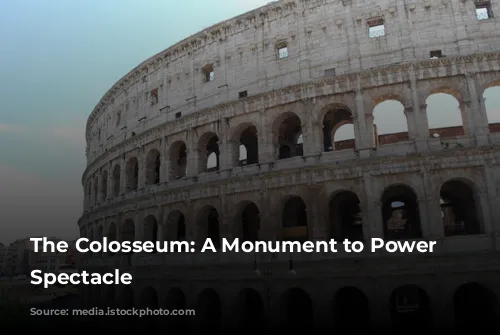The Colosseum, also known as the Flavian Amphitheatre, stands as a towering testament to the grandeur of the Roman Empire. This iconic structure, the largest and most imposing amphitheatre in the Roman world, is not only a symbol of Rome’s past, but also a captivating historical landmark that continues to draw visitors from across the globe.
A Legacy of Power
The Colosseum’s story began with Emperor Vespasian of the Flavia family. He initiated its construction, and his son, Emperor Titus, proudly inaugurated the completed structure in 80 A.D. The opening ceremony, a lavish spectacle lasting one hundred days, showcased the might of the Roman Empire through grand fights, shows, and hunts involving the slaughter of countless animals, a horrifying testament to the Roman thirst for entertainment.
The Colosseum’s Name: A Mystery Unraveled
But why is this magnificent edifice known as the Colosseum? The answer lies in a famous prophecy by the medieval monk Venerable Beda. He declared, “Rome will exist as long as the Colosseum does; when the Colosseum falls so will Rome; when Rome falls so will the world.” It seems Beda may have been inspired by the massive statue of Emperor Nero, “the Colossus,” a towering 35-meter figure that once stood near the amphitheatre. Though now destroyed, this statue likely lent its name to the amphitheatre, thus giving birth to the iconic term “Colosseum.”
A Masterpiece of Roman Engineering
The Colosseum, a testament to Roman engineering prowess, is an awe-inspiring sight. Its elliptical shape, designed to accommodate a greater number of spectators, and its four tiers, each adorned with eighty arches, demonstrate the Romans’ mastery of architecture. The second and third tiers boasted breathtaking decorations, including towering statues, adding to the amphitheatre’s splendor.
The Colosseum’s Construction: A Feat of Ingenuity
The fact that this massive structure was completed in less than ten years is remarkable. The Romans’ secret lay in their skillful application of the arch, a structural marvel that efficiently distributes the weight of heavy constructions. This principle, evident in Roman aqueducts, was cleverly employed in the Colosseum’s design. The Colosseum can be imagined as a series of aqueducts stacked on top of each other, a testament to the Romans’ architectural genius.
The Colosseum’s Transformation: A Story of Decline and Rebirth
Today, we see only a skeletal version of what once was the grandest arena in the ancient world. Over time, the Colosseum fell into disrepair, and three-fifths of its outer brick wall disappeared. During the Middle Ages, its stones, lead, and iron were plundered, becoming building materials for the Barberini Palace, Piazza Venezia, and even St. Peter’s Basilica. The holes visible in the remaining columns serve as poignant reminders of this era of plunder.
A Seat for Every Citizen: Social Order in the Colosseum
The Colosseum could accommodate a massive crowd of up to seventy thousand spectators. Its cleverly designed tiered seating provided optimal viewing angles for everyone, ensuring that no one missed the spectacle. Entrance to the Colosseum was free for all Roman citizens, but seating arrangements reflected social hierarchy. The commoners occupied the upper tiers, segregated by gender, while those of higher social standing enjoyed seats closer to the arena. Senators, vestals, priests, and the emperor himself occupied the front row, enjoying a privileged view of the action.
The Colosseum’s Roof: A Technological Marvel
Just like modern sports stadiums, the Colosseum provided spectators with protection from the sun thanks to its ingenious roof covering, known as the Velarium. This enormous linen tarpaulin, suspended by a system of ropes, winches, and wooden poles, was a breathtaking sight. It required the synchronized efforts of one hundred sailors from the Imperial fleet to maneuver this massive structure, their movements coordinated to the rhythm of a drum.
The Colosseum’s Arena: A Stage for Spectacle
Stepping inside the Colosseum, we see the arena, once a stage for thrilling spectacles, now devoid of its original brick and wood flooring. The cellars below reveal the machinery used for preparing and executing the games. These underground floors housed lifts and hoists, with their visible rails, which were the special effects of the time, used to dramatically hoist animals and gladiators onto the arena through trapdoors, creating a thrilling and unexpected spectacle for the audience. This ingenious system also allowed for the swift deployment of elaborate set backdrops, enhancing the realism of hunting events.
The Colosseum’s Games: A Blend of Entertainment and Propaganda
The shows held in the Colosseum served as a potent combination of entertainment and propaganda, forging a link between citizens and their leader. These public spectacles, while entertaining, also served the purpose of diverting the populace’s attention from political turmoil.
The Colosseum’s Performances: From Animal Hunts to Gladiator Battles
The Colosseum offered a diverse range of performances, each with its own place in the daily schedule. Morning events often featured “Venationes,” thrilling confrontations between exotic animals, or between men and animals. These hunts, sometimes used as a form of public execution, saw individuals left at the mercy of ferocious beasts. The “Silvae,” recreating the atmosphere of a forest with animals, were equally spectacular.
While cruelty was a common feature of these performances, the Colosseum also saw less brutal events, such as the demonstration of an elephant trained to write words in the sand with its trunk. Contrary to popular belief, the Colosseum was not used to execute Christians as a form of public spectacle.
The Colosseum’s Gladiators: Heroes of the Arena
The Colosseum’s most popular event was undoubtedly the gladiatorial contests. As midday approached, the arena would be cleansed of the previous day’s carnage, with sand spread over the bloody floor. Then, to the roar of the crowd, the gladiators would enter the arena in a triumphal procession, their appearance accompanied by the blare of trumpets and the beating of drums.
These gladiators, hailing from the Ludus Magnus, the gladiatorial barracks, were welcomed as heroes, their popularity comparable to that of modern sports champions. After parading around the arena, the gladiators would pay homage to the emperor, saluting him with the famous words “Ave Cesare morituri te salutant” (Hail Caesar, those who are about to die salute you).
The Gladiators’ Story: From Captives to Celebrities
The term gladiator derives from “gladius,” the short sword used by Roman legionaries. While some gladiators were forced into combat, many were prisoners of war granted the choice between slavery and fighting in the arena for a limited period, after which they could gain their freedom and often significant wealth. Others were simply poor individuals seeking fame and fortune. The profession, besides offering good pay, brought them immense popularity, especially among women, who were known to pay substantial sums for a night with these charismatic figures.
Gladiatorial Combat: A Contest of Skill and Valor
There were twelve types of gladiators, each equipped with different weapons and fighting styles. The “Retiarius,” armed with a net, trident, and knife, faced off against opponents wielding shields and sickles, while others wore crested helmets, strong armor, and carried javelins. The selection of gladiators for each fight was carefully considered to create dramatic and exciting matchups.
The Fate of the Defeated: A Cruel Decision
A wounded gladiator could plead for mercy by raising an arm, prompting the audience to appeal to the emperor, seated in his box, to spare his life. The emperor, holding the power of life or death, would then decide the gladiator’s fate. A thumbs-up gesture signified mercy, while a thumbs-down meant certain death.
The Colosseum’s Legacy: A Symbol of Enduring Power
The Colosseum, a monument to both the power and the brutality of the Roman Empire, has endured for centuries. Though its glory days are long gone, its majestic ruins continue to draw millions of visitors each year. The Colosseum stands as a testament to the enduring spirit of the Roman Empire and its impact on the world. As Charles Dickens wrote, “Seeing the Colosseum is seeing the ghost of old Rome floating over the places its people walk in.”
